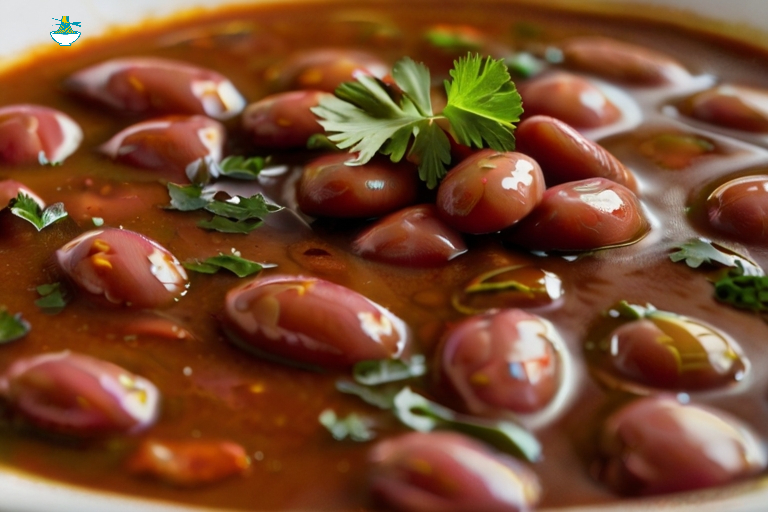Indulge in the rich flavors of the Dominican Republic with this traditional dish of "Habichuelas Guisadas." Translating to "Stewed Beans," this hearty meal is a staple in Dominican cuisine, brimming with vibrant spices, tender beans, and a savory sauce that will tantalize your taste buds. Slow-cooked to perfection, this dish combines the wholesome goodness of beans with a medley of onions, peppers, tomatoes, and aromatic herbs, creating a symphony of flavors that evoke the essence of Caribbean cooking. Whether enjoyed as a comforting meal on its own or paired with rice and plantains, Dominican Republic Habichuelas Guisadas offers a delicious culinary journey straight to the heart of the island.
Here's a simple recipe for authentic Dominican Republic Habichuelas Guisadas:
Ingredients:
- 2 cups of dry red beans (kidney beans), soaked overnight
- 1 medium onion, finely chopped
- 1 bell pepper (green or red), finely chopped
- 2 cloves of garlic, minced
- 2 medium tomatoes, diced
- 1 tablespoon tomato paste
- 1 teaspoon dried oregano
- 1 teaspoon ground cumin
- 1 teaspoon paprika
- Salt and pepper to taste
- 2 tablespoons vegetable oil
- 4 cups water or vegetable broth
- Optional: chopped cilantro for garnish

Instructions:
1- Rinse the soaked red beans thoroughly under cold water and drain.
2- In a large pot or Dutch oven, heat the vegetable oil over medium heat. Add the chopped onions and bell peppers and sauté until they are softened, about 5 minutes.
3- Add the minced garlic to the pot and sauté for an additional minute until fragrant.
4- Stir in the diced tomatoes, tomato paste, dried oregano, ground cumin, paprika, salt, and pepper. Cook the mixture for about 2 minutes, stirring occasionally.
5- Add the soaked red beans to the pot and pour in the water or vegetable broth. Bring the mixture to a boil over high heat.
6- Once boiling, reduce the heat to low, cover the pot, and simmer gently for about 1 to 1 1/2 hours, or until the beans are tender and the sauce has thickened to your desired consistency. Stir occasionally and add more water if necessary to prevent the beans from sticking to the bottom of the pot.
7- Taste and adjust the seasoning with more salt and pepper if needed.
8- Once the beans are cooked through and the sauce is thickened, remove the pot from the heat.
9- Serve the Dominican Republic Habichuelas Guisadas hot, either on their own or over a bed of rice. Garnish with chopped cilantro if desired.
Enjoy your flavorful Dominican dish!
Nutritional Values:
Providing exact nutritional values for ingredients can vary based on factors like brand, preparation method, and serving size. However, here are approximate nutritional values for the ingredients typically used in Habichuelas Guisadas per 100 grams:
Red beans (kidney beans) - Cooked:
- Calories: 127
- Protein: 8.7g
- Carbohydrates: 22.8g
- Fiber: 6.4g
- Fat: 0.5g
benefits: Rich in protein, fiber, folate, iron, and potassium. They promote heart health, aid digestion, regulate blood sugar levels, and support muscle function.
Onion:
- Calories: 40
- Protein: 1.1g
- Carbohydrates: 9.3g
- Fiber: 1.7g
- Fat: 0.1g
benefits:Contains antioxidants, vitamins C and B6, and folate. Onions have anti-inflammatory properties, support immune function, and may improve heart health.
Bell pepper:
- Calories: 31
- Protein: 1.3g
- Carbohydrates: 6g
- Fiber: 2.1g
- Fat: 0.3g
benefits:High in vitamins A, C, and K, as well as antioxidants like beta-carotene and quercetin. Bell peppers support eye health, boost immunity, and may reduce the risk of chronic diseases.
Garlic:
- Calories: 149
- Protein: 6.4g
- Carbohydrates: 33g
- Fiber: 2.1g
- Fat: 0.5g
benefits:Known for its antimicrobial properties, garlic contains vitamins C and B6, manganese, and antioxidants. It may lower cholesterol, support immune function, and reduce blood pressure.
Tomato:
- Calories: 18
- Protein: 0.9g
- Carbohydrates: 3.9g
- Fiber: 1.2g
- Fat: 0.2g
benefits:Rich in vitamins C and K, potassium, and antioxidants like lycopene. Tomatoes promote heart health, support skin health, and may reduce the risk of certain cancers.
Tomato paste:
- Calories: 82
- Protein: 4.3g
- Carbohydrates: 18.9g
- Fiber: 3.9g
- Fat: 0.4g
benefits:Concentrated source of vitamins A and C, as well as antioxidants. Tomato paste adds flavor and richness to dishes while providing essential nutrients.
Oregano (dried):
- Calories: 265
- Protein: 9g
- Carbohydrates: 68g
- Fiber: 42g
- Fat: 4.3g
benefits:Contains antioxidants, vitamins, and minerals like calcium and iron. Oregano has anti-inflammatory properties, supports digestion, and may have antimicrobial effects.
Cumin (ground):
- Calories: 375
- Protein: 17.8g
- Carbohydrates: 44.2g
- Fiber: 10.5g
- Fat: 22.3g
benefits:Rich in iron, magnesium, and antioxidants. Cumin aids digestion, may improve blood sugar control, and has anti-inflammatory properties.
Paprika:
- Calories: 282
- Protein: 14.8g
- Carbohydrates: 53.9g
- Fiber: 37.8g
- Fat: 13.9g
benefits:Contains vitamins A, E, and B6, as well as antioxidants like capsanthin. Paprika supports eye health, boosts immunity, and may improve digestion.
Salt and pepper:
- Nutritional values negligible as typically used in small amounts for seasoning.
benefits:While used in small amounts for flavor, salt provides essential sodium for electrolyte balance, while pepper contains antioxidants like piperine, which may aid digestion and improve nutrient absorption.
Vegetable oil (olive oil used as an example):
- Calories: 884
- Protein: 0g
- Carbohydrates: 0g
- Fiber: 0g
- Fat: 100g
benefits:Depending on the type of oil used, it may provide healthy fats like monounsaturated and polyunsaturated fats, as well as vitamin E. Moderation is key to reap its benefits while minimizing saturated fats.
These values are approximate and may vary based on specific brands and preparation methods. It's also essential to note that the values provided are per 100 grams of each ingredient.


Comments